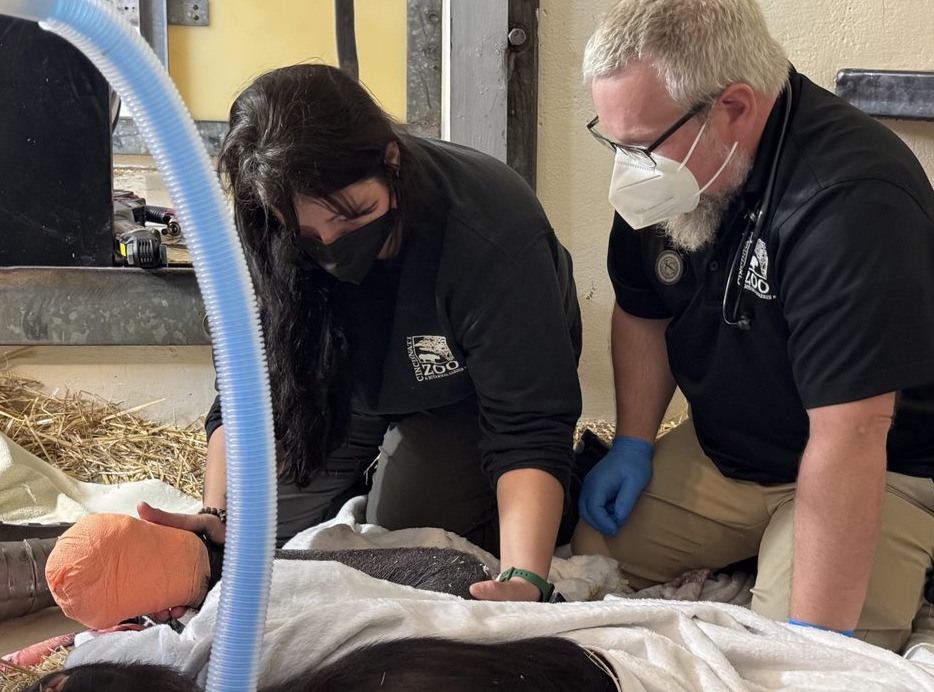Summary of Checkup Shows Young Gorilla’s Titanium Cast is Doing What it Was Specially Designed to Do:
Veterinarians at the Cincinnati Zoo & Botanical Garden are reporting significant progress in the healing of Gladys, an 11-year-old gorilla, who broke her arm in a fight with siblings about a month ago. The injury has responded well to a world-first 3D-printed titanium cast created by Colibrium Additive, a GE Aerospace firm. This custom-designed cast improves a temporary one used during surgery, allowing Gladys better mobility despite its 8-pound weight. The zoo’s primate team has been providing round-the-clock care, including pain management and isolation from her troop, although she remains in visual and auditory contact with them.
Continued monitoring and x-rays indicate positive healing, leading to plans to keep Gladys in the cast for a few more weeks, followed by physical therapy (PT) to restore full arm function. During her recovery process, which includes keeping her arm mobile to prevent stiffness, Gladys will be kept away from public view until she’s ready to be reintegrated with her troop. Meanwhile, the zoo encourages visitors to check out other attractions, including Zoo Babies and highlights the savings available through online ticket purchases.
– Advances in veterinary care for wildlife using 3D-printed titanium casts
– The roles and responsibilities of zookeepers and veterinarians in the rehabilitation of injured animals
– The significance of wildlife conservation and the impact of human intervention on animal health and welfare
– The technical and ethical considerations in the use of advanced technology for animal treatment
– Collaboration between zoos, technology companies, and healthcare professionals to improve animal care
—
The recent medical checkup of an 11-year-old gorilla named Gladys at the Cincinnati Zoo & Botanical Garden has showcased the healing progress of her broken arm, thanks to the world’s first 3D-printed titanium cast. This significant development marks a milestone in veterinary care and highlights the complex coordination between zookeepers, veterinarians, technology companies, and healthcare professionals in advancing wildlife conservation efforts.
Due to an altercation with her siblings, Gladys’ injury required an innovative approach due to the unique challenges of gorilla anatomy and behavior. The collaboration with Colibrium Additive, a GE Aerospace company, led to the design and creation of a lightweight, durable cast capable of withstanding the physical demands of an active gorilla. Unlike traditional casts, the titanium version provided by GE Additive improved Gladys’s quality of life during her recovery, allowing for greater mobility and comfort.
The veterinary and caregiver teams at the Cincinnati Zoo have been pivotal in Gladys’ recovery. Their dedication to round-the-clock monitoring and care, including pain management and physical therapy, exemplifies the zoo’s commitment to ensuring the health and well-being of its inhabitants. The rehabilitation process involves the physical healing of the bone and the maintenance of muscle strength and flexibility to prevent long-term impairment.
Wildlife conservation is a critical aspect of modern zoo missions, extending beyond caring for injured animals to encompass education, research, and participation in global conservation initiatives. The story of Gladys serves as a compelling narrative that highlights the zoo’s role in preserving endangered species, such as gorillas, through direct care, public engagement, and scientific research. By sharing these stories, zoos foster a deeper understanding and appreciation of wildlife and the challenges they face in the wild and in human care.
The use of advanced technology, like the 3D-printed titanium cast for Gladys, raises important technical and ethical considerations. Adapting human medical technologies for veterinary use must account for differences in anatomy, physiology, and behavior among species. Additionally, animal welfare is paramount, guiding decisions about when and how to employ these technologies. The successful application in Gladys’ case opens the door for broader use in veterinary medicine, offering hope for more effective treatment of injuries in wildlife and pets alike.
Collaboration is a cornerstone of modern animal care, particularly for cases requiring specialized treatment. The partnership between the Cincinnati Zoo, healthcare institutions, and technology companies underscores the potential for interdisciplinary approaches to solve complex challenges. By pooling knowledge and resources, these collaborations push the boundaries of what is possible in animal health and welfare.
In summary, the care provided to Gladys the gorilla demonstrates a multifaceted approach to wildlife conservation and veterinary medicine, involving advanced technology, dedicated professionals, and a deep understanding of animal needs. As zoos evolve, their role as caretakers, educators, and conservation advocates becomes increasingly vital in our shared world. Through stories like Gladys’, zoos inspire and educate the public, fostering a connection with the natural world that is crucial for the future of biodiversity and ecosystem health.


